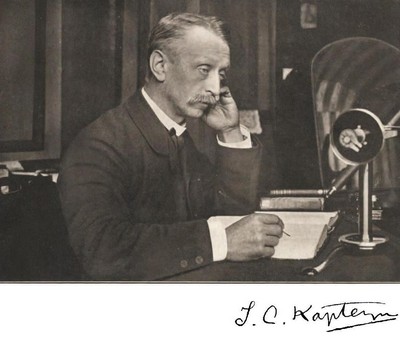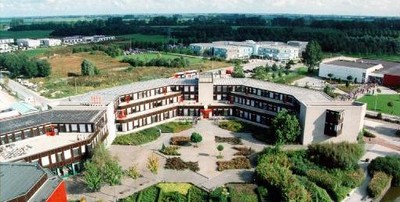Kapteyn and his Universe - review
Jacobus Cornelius Kapteyn is one of the most influential Dutch astronomers you may never have heard of. He has a star named after him, but that is small fry compared to the Oort Cloud or the Kuiper Belt, and his model of the Milky Way was outdated almost as soon as he published it. Yet Kapteyn played an important role in early professional astronomy, as data rapidly became too big to handle.

University of Groningen Professor Emeritus of Astronomy Piet van der Kruit has described the life and work of Kapteyn in an almost 700 page long biography. He spent years collecting and studying Kapteyn’s correspondence, meeting reports and the many scientific papers written by Kapteyn, the first Professor of Astronomy in Groningen. His name lives on there in the Kapteyn Institute for Astronomy.
Kapteyn came to Groningen after studying mathematics in Utrecht and spending some time at the Leiden University Observatory. Accepting the new Astronomy chair in 1877 was something of a gamble: there was no observatory and no real astronomy tradition in Groningen.
Indeed, Kapteyn wasn’t quite sure what to do in the first years of his career. He tried hard to obtain funds for an observatory, but this never materialized: the two established observatories in Utrecht and Leiden seemed more than enough for a small (and very cloudy!) country like the Netherlands.

Kapteyn did do some climate research on tree-rings, but short biographies have thus far concluded that his first years in Groningen where rather unproductive. However, Van der Kruit has discovered that Kapteyn was indeed doing astronomical research, developing ideas and making plans. He was able to use the Leiden telescope on occasion, and entered into correspondence with other astronomers, often on technical matters regarding observations.
His ‘breakthrough’ came in the form of cooperation with British astronomer David Gill, who ran an observatory in South Africa. Van der Kruit quotes extensively from the correspondence between the two and shows that it wasn’t so much a case of an underworked astronomer – Kapteyn – offering to help an overworked astronomer, but rather of a relationship that grew from mutual appreciation and respect.
Gill was pioneering the use of photographic plates to study the position of stars. This meant that where one observer would previously measure stars one by one, he could now take a picture of dozens of stars that could then be measured. This increased the amount of data generated and Gill was seriously short of staff to analyze it.

This is where Kapteyn came in. He (and several assistants) took on the task of analyzing the photographic plates, and this eventually resulted in the ‘Cape Photographic Durchmusterung’. He even designed equipment to obtain accurate readings from the photographic plates, which were made from glass.
Kapteyn played a prominent role in developing and validating new methods, but his aim was always to obtain more information, rather than simply to improve the accuracy of his measurements. For example, he tried to devise rules for estimating the distance to a star based on the observed light intensity and used statistical methods to find patterns in the movement of stars.
Measuring the position (and if possible the movement) of stars was a fast-moving, exciting field. Remember, we’re talking late nineteenth century here, when astronomers had no idea of the size of the Universe, nor did they know that ours wasn’t the only galaxy.

The next step was to make sense of all the star data. Fast forward to the end of Kapteyn’s career. In 1922 (a year after retiring and the year of his death) he published a map of the Milky Way, now called ‘The Kapteyn Universe’. As Kapteyn was unaware that interstellar dust absorbs stellar light, something that was just being discovered, his model was wrong. However, it was arguably the best anyone could have done at the time.
What happened in the intervening period? Van der Kruit provides much insight into Kapteyn’s career and character. He was amiable, a real networker and humble – but at the same time knew exactly what he wanted. Kapteyn initiated several global partnerships, played a role in the fledgling professional organizations for astronomers (national and international) and was a respected scholar.
His lack of an observatory was more or less made up for by his appointment as research associate at Mount Wilson Observatory in the United States. For years, he would visit this observatory during the summer, and a small lodge was built for him and his wife, which is still there.

In the biography Kapteyn comes across as someone who never took center stage unless he had to, but who was of great influence behind the scenes. And even though he was full of ideas, he spent much of his time simply measuring plates obtained by others. His ideas needed data, and the only way to get the right data was to collect it himself.
His impact on astronomy – both nationally and internationally – has been profound. He was one of the first to realize that astronomers were producing more data than they could analyze. He responded by making data analysis his main concern, but he also played a role in the evolution of astronomy from a supporting science of timekeeping and navigation into a science of its own that would throw light on the origins and development of the Universe.

Van der Kruit follows both the scientific career and the professional and private life of Kapteyn in great detail. He analyses his scientific papers and his correspondence with colleagues and friends, and tries to piece together what drove this man. The effort is commendable, although the level of detail, especially where the science is concerned, can be overwhelming for those unfamiliar with astronomy.
The biography also shows how astronomy developed from a hobby for the lucky few into a professional science, something that happened before modern methods of communication or transportation became available. A European scientist would have had to travel for weeks to attend a conference in the United States!
All this makes the biography an intriguing read. However, it must be said that the author is clearly a scholar rather than a gifted biographer. As already mentioned, the level of scientific detail is difficult for those without a background in astronomy. Consequently, the lengthy interruptions to analyze scientific papers can be a challenge. Despite this, Van der Kruit has managed to make Kapteyn’s star shine brightly amidst his generation.
Written by René Fransen, Science Writer at Science LinX, University of Groningen
Pieter C. van der Kruit: Jacobus Cornelius Kapteyn. Born investigator of the Heavens . Springer 2015 (Astrophysics and Space Science Library 416), 698 pages, hardback $279,- e-book $219
More news
-
11 December 2025
Stormy planets and an unexpected atmosphere
-
09 December 2025
University of Groningen Professor at COP30: ‘There is always drama’
